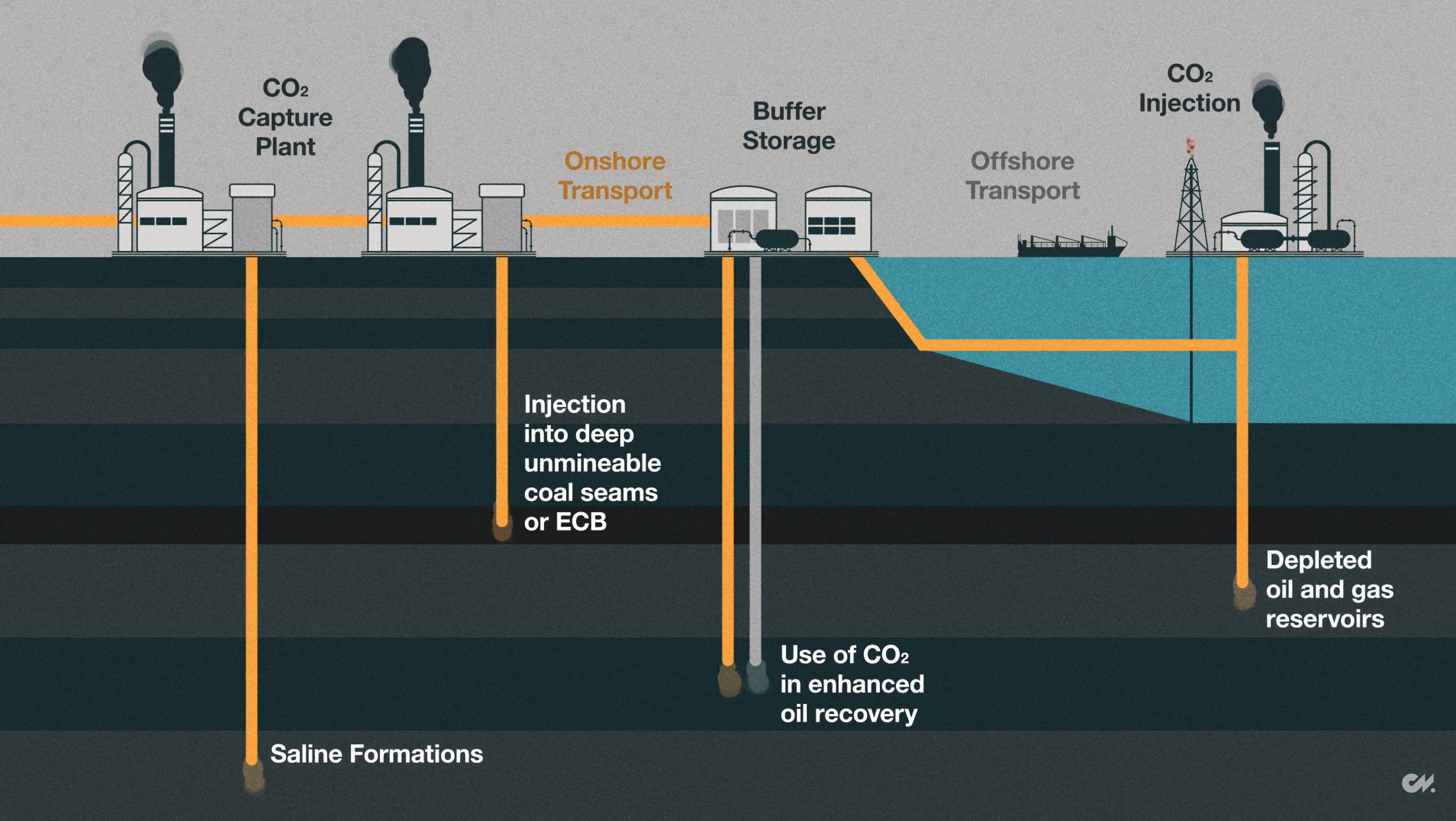Episode Transcript
Achieving net-zero emissions by 2050 on a global scale requires not only reducing anthropogenic carbon emissions, but also removing the carbon that has accumulated in the atmosphere since the industrial revolution. In this episode, we provide an overview of several carbon dioxide removal or CDR technologies, how they work, their costs and the associated challenges with deploying them at the scales we require. The first question is how much carbon do we need to remove from the atmosphere to limit global warming to 1.5 degrees Celsius. Climate Now spoke with Dr. Roger Aines who leads the carbon initiative at the Lawrence Livermore National Laboratory
Roger Aines:
1.5 degrees C is dauntingly difficult to do, and in order to do so, we’re going to have to remove a lot of the CO2 that we’ve already put there, make up for the fact that we were too slow, and the amounts are staggering. By the middle of the century, 2050, we’ll have to remove 10 billion tons per year of CO2 from the atmosphere. What is 10 billion tons? We produce 5 billion tons of oil worldwide a year. So that means 10 billion tons means between now and 2050 we have to create this entirely new industry, whatever it is, to remove this, something that’s twice the size of today’s oil industry.
Understanding the scale of the problem and why it’s important, let’s discuss some of the most commonly cited CDR options and their associated costs. We can separate CDR methods into two categories, natural carbon sinks that we want to enhance such as forest, soil, sequestration, and mineralization. And those that are more technologically intensive, such as direct air capture, bio energy and carbon capture and storage, otherwise known as BECCS, and underground geological storage of CO2. Each of these methods comes in multiple varieties and much of the work on them is still in the experimental or very early commercial phases. So the numbers that we have in terms of amounts of CO2, sequestered, and costs are yet to be proven on a commercial scale. We include all of our sources at the end of our videos and in the transcripts on climatenow.com, so you can always go deeper if you wish.
OCEANS
Before continuing, it’s important to note that oceans also play a huge role in absorbing carbon from the atmosphere. Naturally, the oceans take in an average of 25% of what is released annually into the atmosphere. The way the oceans and the atmosphere interact is very complex. But what is certain is that we do not want to increase the amount of carbon stored in the oceans, as this is contributing to ocean acidification and the extinction of species. Now let’s break down our main CDR methods.
FORESTATION
Forestation refers to the planting of trees on lands that are degraded or reconverting land. That was once forested, but is now used for commercial purposes. In the United States there are an estimated 133 million acres available for reforestation, which means roughly 333 million additional tons of CO2 could be sequestered annually. Globally, there are 1.67 billion acres of land available for forest restoration. If these global forestation efforts were to succeed, study suggests that by 2050, these forests would have a net potential to store between 0.5 and 3.6 billion tons of CO2 annually. Compared to the need to remove 10 billion tons annually, this represents in the very best case about a third of what we need to be storing. In terms of costs, this is one of the most affordable methods of CDR at $5 to $50 a ton of CO2 sequestered. A 2018 paper in Environmental Letters Research specifies that differences in cost effectiveness could be due to multiple factors, such as yield rates and land prices, transaction costs and reporting differences. That said there are several challenges with forestation. One of which is carbon accounting. Methodologies to accurately measure the CO2 sequestered by forestation efforts are not standardized and determining the duration for which trees are able to grow and continue to absorb CO2 and store that CO2, otherwise known as permanence of sequestration, is challenging.
DIRECT AIR CAPTURE
Moving on to more technologically intensive solutions for CDR, one of the most widely discussed is direct air capture or direct air capture with storage. A wide range of technologies are currently being developed to directly capture CO2 from the ambient air and their capabilities have the potential to remove between 0.5 and 5 billion, tons of CO2 annually. In the best case scenario, we are looking at another strategy that can handle about half of our global sequestration needs. However, capturing the CO2 using this type of technology is very expensive. Dr. Howard Hertzog, a senior engineer at the MIT Energy Initiative, and one of the pioneers of carbon capture and sequestration has this to say about it:
Howard Herzog:
Carbon Engineering thinks they can do it for between $100 and $300, a ton of CO2. I’ve done a lot of analysis. I don’t think those numbers are credible, at least not in the near future. I, you know, people ask me what the range will be in 2030. I give them a range of $600 to a $1,000 a ton of CO2. Even at $600 to a $1,000 dollars a ton of CO2, that still may be cheaper than getting the jet fuel off the airplane.
Defenders of direct air capture emphasize that this is just the starter cost as technologies improve and scale up. They say they have the potential to go down to $100 to $300 per ton. Many experts agree that this CDR method isn’t the most cost effective, but major oil companies like Chevron, Shell and TotalEnergies have been willing to invest given the increasing global pressure to be part of the solution.
BECCS
Another CDR method is BECCS: bioenergy with carbon capture and storage. Bioenergy is derived from biomass that is converted into electricity or liquid fuel. CO2 released in this process is then captured and stored underground. Natural resource economist. Dr. Matthew Langholtz at the Oak Ridge National Laboratory puts into perspective how much carbon can be stored using BECCS in the United States.
Matthew Langholtz:
There’s been previous work estimating up to about 700 million tons potentially of CO2 sequestered annually. Basically in the near term, you know, using the near term resources, you could sequester about 200 million tons per year. If you add energy crops, you can sequester up to 700 million tons per year. Another way to put it in context is the IPCC pathway 2 says, you might need, the world might need a billion tons of CO2 sequestered per year to achieve carbon neutral in one of their scenarios. Here you could do most of that from the US alone. So, it’s not everything, it’s not enough for the solution, but it could be a key part of the overall de-carbonization solution.
To put that into context, 700 million tons per year is 13% of the United States’ total CO2 emissions in 2019. Globally, BECCS can store an estimated 0.5 to 5 billion tons of CO2 annually. So not only does BECCS have the potential to remove half of our target, 10 billion tons of CO2 annually, but current cost estimates for this technology put it as low as $15 per ton CO2, according to the global CCS Institute. This low cost assumes that the resulting biofuel is used in the most suitable power plants, and that there is easy access to abundant biomass and underground storage sites. It also assumes biomass fuel costs that are lower than the price of coal. On the other hand, the cost of BECCS can go up to $400 per ton of CO2, depending on the biofuel production method. It is also important to note that since biomass is largely sourced from special forestry byproducts or crops grown specifically for this purpose, there is little to no risk that biofuel production will compete with land use or forestation efforts.
SOIL
Next, we have soil carbon sequestration, rich and untilled soil is a highly dense and natural carbon sink. Studies estimate that at a depth of just two meters, the earth’s soils currently hold 2,600 billion tons of CO2. How is this possible? Well, soil organic matter traps carbon via several ecosystem processes, such as photosynthesis, respiration of microbes and fungi, as well as decomposition of organic material. However, rates of soil carbon uptake change with climate and human activity. The equivalent of 175 to 350 billion, tons of carbon dioxide have been released through the conversion of natural to agricultural ecosystems, total losses of soil, organic carbon, as a result of land use changes account for a third of anthropogenic CO2 in the atmosphere. While these losses are significant, studies estimate that by 2050, up to 5 billion tons of CO2 could be sequestered in soils annually. That’s already half of our 2050 global CO2 sequestration needs. Though it’s important to note that soil carbon uptake declines after 20 to 40 years as soils build up to their maximum potential. To maximize soil carbon sequestration, a variety of practices need to be implemented, including low till or no till crop management, improved planting schedules, and management of grazing livestock. Estimated costs of making these changes are between zero to a hundred dollars per ton CO2.
MINERALIZATION
Another long-term and natural solution to CDR is a method known as mineralization. Here, CO2 reacts with compounds like magnesium oxide and calcium oxide found in minerals like olivine, serpentine, and limestone to trap CO2 into a solid state. The end products of these reactions are environmentally safe and do not require post storage monitoring. Today there are several companies trying to use this method to monetize products made from the resulting compounds. As you can see in this diagram, by using CO2 as a feedstock to create a product that is two thirds magnesite and one third amorphous silica, this process can be used to manufacture concrete, paper, and polymers. The problem is that it’s very difficult to penetrate these industries from both a cost and supply chain perspective. We cover these issues in a podcast with the founder of one company involved in these efforts: Green Minerals. It is estimated that the cumulative annual production rates of industrial waste materials have a total CO2 uptake capacity of 0.5 to 1 billion tons per year at a cost as low as $48 per ton CO2, but a potentially unlimited amount of CO2 could be stored per year via mineralization in natural basalt formations, limited only by our ability to get the CO2 to these formations. The cost of this type of mineralization ranges from $7 to $30 per ton.
GEOLOGIC STORAGE
The last component of the current CDR portfolio involves the geological storage of carbon. Storage technology is integral to both BECCS and direct air capture strategies as it provides a means to store large amounts of pure CO2. By looking at this diagram, we can see that this is done by taking CO2 captured at power plants, turning it into super critical CO2, transporting it either to onshore or offshore storage sites and injecting it into the ground or deep water.

In this image, we see that there are four available methods to store the CO2. The methods are: injection into deep salt formations or into un-mineable coal beds for enhanced methane recovery. CO2 can also be used to enhance current oil and gas recovery, or can be injected back into depleted oil and gas reservoirs to restore pressure levels. These geological formations are located all around the planet and have the capacity to store a total of 25,000 billion tons of CO2. The challenge here however is strategically choosing storage sites and determining the rate at which CO2 can be sequestered. Sequestering carbon in deep sedimentary basins comes at an estimated cost of $7 to $13 per ton CO2. The price tag includes the cost of well drilling, injection monitoring, maintenance and other incidental costs. However, it does not include any remediation costs should any well leakage or groundwater contamination occur. Geological storage of CO2 also comes with a risk of inducing seismic activity, which means the pressure within these wells would need to be monitored closely. However, the technology and methods are well understood. The oil industry has been sequestering carbon dioxide underground since the 1970s, as a technique to enhance oil recovery.
These six CDR strategies, forestation, soil carbon sequestration, mineralization, direct air capture, bioenergy with carbon capture and storage, and geological storage only skimmed the surface of what’s currently out there. Their associated prices and sequestration potential are also likely to become more certain as technologies evolve and policies are introduced to support their development. What cannot be stressed enough is that at the end of the day, the only way we’ll reach net-zero globally by 2050 will be by investing in all of these CDR technologies. While we focused on the best case scenarios in this video, which would allow us to store close to 21 billion tons of CO2 annually, worst case scenario estimates wouldn’t get us even to half of our global sequestration needs.
For a deeper dive into this topic, check out our full-length podcast episodes with experts, Howard Hertzog, Roger Aines, and Matthew Langholtz, where we dig deeper into the evolution and the current state of CDR technologies. To find out more about each CDR strategy mentioned in this video, check out our technology video series that will delve deeper into each one. To sign up for our new releases and more visit climatenow.com. Thanks and see you next time.
Sources
- 00:16 Videos from Carbon Engineering
- 2:35 NOAA. (n.d.). Ocean-Atmosphere CO2 Exchange. Ocean-Atmosphere CO2 Exchange Dataset | Science On a Sphere. https://sos.noaa.gov/datasets/ocean-atmosphere-co2-exchange/#:~:text=Notable%20Features-,When%20carbon%20dioxide%20CO2%20is%20released%20into%20the%20atmosphere,certain%20areas%20of%20the%20ocean
- 2:49 Ocean acidification. Ocean acidification | National Oceanic and Atmospheric Administration. (2016, July 20). https://www.noaa.gov/education/resource-collections/ocean-coasts/ocean-acidification
- 3:02 Nyland, R.D. Silviculture: Concepts and Applications. 3rd ed. 2016. p. 67.
- 3:10 https://www.reforestationhub.org/
- 3:18, 8:36 Griscom, B. W., Adams, J., Ellis, P. W., Houghton, R. A., Lomax, G., Miteva, D. A., Schlesinger, W. H., Shoch, D., Siikamäki, J. V., Smith, P., Woodbury, P., Zganjar, C., Blackman, A., Campari, J., Conant, R. T., Delgado, C., Elias, P., Gopalakrishna, T., Hamsik, M. R., … Fargione, J. (2017, October 31). Natural climate solutions. PNAS. https://www.pnas.org/content/114/44/11645
- 3:29, 3:55, 4:40, 5:39, 7:18, 7:51 Fuss, S., Lamb, W. F., Callaghan, M. W., Hilaire, J., Creutzig, F., Amann, T., Beringer, T., Garcia, W. de O., Hartmann, J., Khanna, T., Luderer, G., Nemet6, G., Rogel, J., Smith, P., Vicente, J. L. V., Wilcox, J., Dominguez, M. del M. Z., & Minx, J. C. (2018, May 22). Negative emissions—Part 2: Costs, potentials and side effects. Environmental Research Letters. https://iopscience.iop.org/article/10.1088/1748-9326/aabf9f/meta
- 7:12, 7:51 Ritchie, H., & Roser, M. (2020, June 11). United States: CO2 Country Profile. Our World in Data. https://ourworldindata.org/co2/country/united-states?country=~USA
- 7:30 Consoli, C. (2019). Bioenergy and Carbon Capture and Storage. Global CCS Institute. https://www.globalccsinstitute.com/resources/publications-reports-research/bioenergy-and-carbon-capture-and-storage/
- 8:10 Ontl, T.A., & Schulte, L.A. (2012). Soil Carbon Storage. Nature Education Knowledge 3(10):35. https://www.nature.com/scitable/knowledge/library/soil-carbon-storage-84223790/
- 8:20 The National Academies Press. (2019). Sequestration of Supercritical CO2 in Deep Sedimentary Geological Formations. In Negative emissions technologies and reliable sequestration: a research agenda (pp. 319-350). Book.
- 8:45 Lal, R. (2009) Sequestering atmospheric carbon dioxide. Critical Reviews in Plant Science 28, 90-96
- 9:13 McKinsey & Company. (2018, December 11). Pathways to a low-carbon economy: Version 2 of the Global Greenhouse Gas Abatement Cost Curve. McKinsey & Company. https://www.mckinsey.com/business-functions/sustainability/our-insights/pathways-to-a-low-carbon-economy
- 9:30 Fact Sheet: Soil Carbon Sequestration. American University. (2020, June 24). https://www.american.edu/sis/centers/carbon-removal/fact-sheet-soil-carbon-sequestration.cfm
- 9:45, 10:38 Hills, C. D., Tripathi, N., & Carey, P. J. (2020, June 10). Mineralization Technology for Carbon Capture, Utilization, and Storage. Frontiers. https://www.frontiersin.org/articles/10.3389/fenrg.2020.00142/full
- 9:45 The National Academies Press. (2019). Carbon Mineralization of CO2. In Negative emissions technologies and reliable sequestration: a research agenda (pp. 247-318). Book.
- 9:53 Zevenhoven, R., & Fagerlund, J. (2014, March 27). Mineralisation of carbon dioxide (CO2). Developments and Innovation in Carbon Dioxide (CO2) Capture and Storage Technology. https://www.sciencedirect.com/science/article/pii/B9781845697976500163
- 10:13 Reduced CO2 emission & CO2-based materials – Green Minerals. Green Minerals. (2018). https://www.green-minerals.nl/wp-content/uploads/2018/08/20180801_1-pager-Green-Minerals.pdf
- 10:54 Kelemen, P., et al. (2019) An overview of the status and challenges of CO2 storage in minerals and geological formations. Frontiers in Climate, 1, 9. https://doi.org/10.3389/fclim.2019.00009
- 11:20 Transporting CO2. Global CCS Institute. (2015, May 7). https://www.globalccsinstitute.com/resources/publications-reports-research/transporting-co2/
- 11:33, 12:25 Secure geologic storage of CO2. Global CCS Institute. (2015, May 5). https://www.globalccsinstitute.com/archive/hub/publications/191013/fact-sheet-secure-geologic-storage-co2.pdf
- 11:50, 12:05 The National Academies Press. (2019). Sequestration of Supercritical CO2 in Deep Sedimentary Geological Formations. In Negative emissions technologies and reliable sequestration: a research agenda (pp. 319–350). Book.
- 12:36 Global CCS Institute (2018) A solution to climate change right beneath our feet. https://unfccc.int/sites/default/files/resource/40_UNFCCC%20Submission_Global%20CCS%20Institute.pdf
- 13:09 Global CCS Institute (2020) The Global Status of CCS: 2020. Australia









